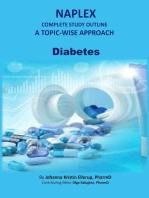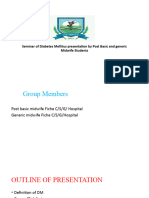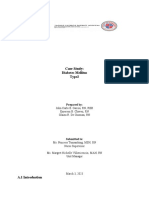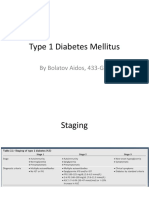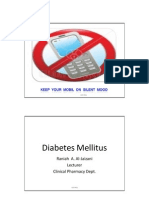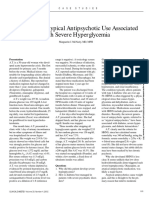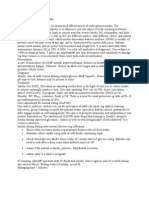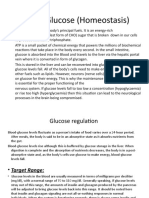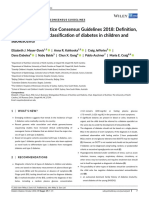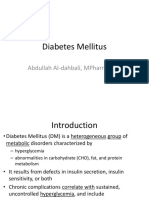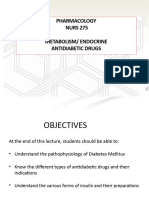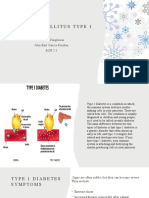Professional Documents
Culture Documents
Appoach To Brittle Diabetes: Clinical Algorithm To Determine The Etiology
Appoach To Brittle Diabetes: Clinical Algorithm To Determine The Etiology
Uploaded by
Mudassar SattarOriginal Description:
Original Title
Copyright
Available Formats
Share this document
Did you find this document useful?
Is this content inappropriate?
Report this DocumentCopyright:
Available Formats
Appoach To Brittle Diabetes: Clinical Algorithm To Determine The Etiology
Appoach To Brittle Diabetes: Clinical Algorithm To Determine The Etiology
Uploaded by
Mudassar SattarCopyright:
Available Formats
C H A P T E R
Appoach to Brittle Diabetes
162 Seetha Raju
INTRODUCTION CLINICAL ALGORITHM TO DETERMINE THE ETIOLOGY
Brittle diabetes is defined as severe instability of blood The diagnostic algorithm was the glucose response
glucose levels with frequent and unpredictable episodes to 0.1 unit / kg insulin administered subcutaneously
of hypoglycaemia or ketoacidosis that disrupts day to and intravenously. If this response was ’’normal’’ then
day life. Almost all diabetics experience swings of blood psycosocial evaluations were completed, including
sugar which are less predictable and greater than in non psycolinguistic and health psycological testing.Then
diabetics. Brittle diabetes is uncommon (less than 1% of other parameters affecting blood glucose concentration
insulin taking population) and it causes a huge burden eg. gastric motility, counter regulatory hormones, coeliac
on the patient due to multiple hospital admissions. It disease, hypothyroidism, adrenal insufficiency, insulin
is episodic and almost always related to stressful life autoantibodies and most importantly patients compliance
situations. It affects 3/1000 insulin dependent diabetic with prescribed regimens were assessed. If the response
patients mainly young women. Its prognosis is poor were ‘’abnormal’’ the location of the insulin resistance
with lower quality of life scores, more microvascular and was identified as being subcutaneous, intravascular or at
pregnancy complications and shortened life expectancy. the peripheral tissue.
CAUSES OF BRITTLE DIABETES EVALUATION AND DIAGNOSIS
Main causes includes A careful evaluation should be performed in patients
• Non physiologic matching of meals/exercise and with brittle diabetes. A detailed history as to the duration
insulin administration. of diabetes, description of episodes of DK, severe
hypos, presence of diabetic complications (particularly
• Malabsorption autonomic neuropathy) and prescribed insulin regimens
• Certain Drugs (alcohol, antipsycotics) should be taken. It should also be determined if there
was a period of stable diabetes preceeding the brittleness
• Defective insulin absorption or degradation
and what happened in the patient’s life circumstances
• Defect of hyperglycaemic hormones especially coincident with the onset of brittleness. Psycosocial factors
glucocorticoid and glucagon. need to be assessed. For patients with recurrent episodes
of DK, a possible chronic cryptic infection (sinusitis,
• Delayed gastric emptying as a result of autonomic
osteomyelitis, renal or perirenal abscess and lung abscess)
neuropathy.
should be excluded. For all patients a diabetic educational
• Psycosocial factors are very important and assessment is useful to evaluate whether the patients
factitious brittleness may lead to a self perpetuating knows how to manage diabetes and rule out diabetes
condition. This is because of patient centred mismanagement (factitious brittle diabetes ). In this case a
behavioral issues. Some of these problems may “in hospital” assessment and management of blood sugar
be short lived and related to a stressful situation is necessary.
(unhappiness at school or home).
Iatrogenic hypoglycaemia is the result of the interplay
CLINICAL MANIFESTATIONS of absolute or relative therapeutic insulin excess and
Patients have wide swings of blood sugar levels and compromised physiological and behavioural defences
report differing blood sugar responses to the same dose against falling plasma glucose concentrations in type 1
and type of insulin. Most patients are in their twenties diabetes in type 1 diabetes mellitus (T1DM) and advanced
or thirties. Their glycated haemoglobin (HbA1c) are type 2 diabetes mellitus (T2DM). Courtesy of Dr. Philip
typically elevated (10-14%) and acute complications (DK Cryer.
and hypo) and chronic microvascular complications are
commoner (67% versus 25%). Brittle diabetics also had a
MANAGEMENT
lower quality of life score. The age of death ranges from Brittle diabetes is difficult to treat
27-45 years with a predominance in young women. Those General principle
who survived had resolution of brittleness, but suffered a • Patients to be instructed how to match the insulin
significant complication burden. Frequent hypoglycaemia dose to the amount of carbohydrates ingested.
even if asymptomatic causes both defective glucose • Insulin regimens must be individually tailored to
counter regulation and hypoglycaemia unawareness and reduce the risk of hypoglycaemia while matching
thus a viscious cycle of recurrent hypoglycaemia.
756
Table 1: Counterregulatory response to hypoglycaemia
Condition Glucose Insulin Glucagon Epinephrine
Nondiabetic Decreases Increases Increases
T1DM No Decrease* No Increase Attenuated Increase*
T2DM
Early Decreases Increases Increases
Late(Absolute endogenous No Decrease* No Increase Attenuated Increase*
insulin deficient)
DIABETES
glycaemic control. The use of insulin analogues or clinician error in management, other causes
with ultrafast or ultraslow action and use of being psycosocial, malabsorbtion, delayed gastric
subcutaneous insulin pumps are effective in brittle emptying, systemic insulin resistance.
diabetes.
• The treatment includes diabetes education,
• SMBG is an excellent tool for the patients and a intensive insulin therapy with frequent or
motivated patient can use this tool to manage his continuous glucose monitoring and constant
blood sugars. interaction between patient and the clinician.
Psycotherapy is advocated in selected patients.
• CGM (Continuous glucose monitoring) may
further facilitate the understanding of glycaemic REFERENCES
variability. 1. David K McCullrch. M.D.David M.Nathan. M.D.Jean E
Mulder M.D. - The adult patient win diabetes mellitus Up
• Sensor augmented insulin pumps (an insulin To Date June 2015.
pump with a CGM device) improves glycemic
2. Cartwright A, Wallymahmed M, Macfarlaane IA, et al. The
control without hypoglycaemia. outcome of brittle type 1 diabetes –a 20 year study QJM
• Fully automated closed loop systems of insulin 2011; 104:575.
delivery based on CGM sensing (bionic pancreases) 3. Vantyghem MC,press M.management strategies for brittle
are available. This device also integrates glucagon diabetes. Ann Endocrinol (Paris) 2006; 67:287.
delivery. 4. Clar C, Barnard K, Cummins E, et al. Self – monitoring of
blood glucose in type 2 diabetes; systematic review Health
• Islet cell transplantation –an effective therapeutic Technol Assess 2010; 14:1.
option entailing good expected outcomes. The
5. Polonsky WH, Fisher L, Schikman CH, et al. Structured
limiting factor is the effect of immunosuppressive self-monitoring of blood glucose significantly reduces
therapy and recurrence of autoimmunity. A1C levels in poorly controlled, noninsulin-treated type
2 diabetes : results from the structured Testing Program
SPECIAL SITUATIONS study. Diabetes Care 2011; 34:262.
• Hypoglycaemia unawareness A 2-3 Week period
6. Gandhi GY, Kovalaske M, Kudva Y, et al. Effcacy of
of scrupulous avoidance of hypoglycaemia is
continuous glucose monitoring in improving glycemic
advisable since that often restores awareness (Table control and reduceing hypoglycemia :a systematic review
1). and meta – analysis of randomized trials. J Diabetes Sci
• Gastroparesis – promotility agents improved Technol 2011; 5:952.
gastric enptying and relieved the symptoms of 7. Szypowska A, Ramotowska A, Dzygalo K, Golocki D.
gastroparesis but did not help with metabolic Beneficial effect of real-time countious glucose monitoring
system on gycemic control in type 1 diabetic patients:
control.
systemic review and meta-analysis of randomized trials.
• Psycosocial – Psycotherapy may help in selected Eur J Endocrinol 2012; 166:567.
patients. 8. Yeh HC, Brown TT, Maruthur N, et al. Comparative
effectiveness and safety of insulin delivery and glucose
SUMMARY AND RECOMMENDATIONS monitoring for diabetes mellitus : a systematic review and
• Brittle diabetes in defined as severe instability meta-analysis. Ann Intern Med 2012; 157:336.
of blood glucose levels with frequent and 9. Juvenile Diabetes Research Foundation Continuous glucose
unpredictable episodes of hypoglycaemia or monitoring study Group, Beck RW, Buckingham B, et al.
ketoacidosis. Factors predictive of use and of benefit from continuous
glucose monitoring in type 1 diabetes. Diabetescare 2009;
• The diagnosis is established when a patient with 32:1947.
absolute insulin deficiency (type 1 or type 2) has
10. Ritholz MD, Atakov-Castillo A, Beste M, et al. Psychosocial
frequent episodes of hyper or hypoglycaemia.
factors associated with use of continuous glucose
• The major cause of brittle diabetes is patient monitoring. Diabet Med 2010; 27:1060.
You might also like
- NP1 CHN 2018 PDFDocument86 pagesNP1 CHN 2018 PDFJOHN CARLO APATANNo ratings yet
- Case Study 18Document8 pagesCase Study 18api-535288765No ratings yet
- Diabetes Research PaperDocument7 pagesDiabetes Research PaperLysol007100% (3)
- Naplex Complete Study Outline A Topic-Wise Approach DiabetesFrom EverandNaplex Complete Study Outline A Topic-Wise Approach DiabetesRating: 4 out of 5 stars4/5 (3)
- Glucose Assay by Dinitrosalicylic Colorimetric MethodDocument6 pagesGlucose Assay by Dinitrosalicylic Colorimetric MethodHaikal IskandarNo ratings yet
- Paeda DMDocument38 pagesPaeda DMAmanuel LemiNo ratings yet
- HypoglycemiaDocument19 pagesHypoglycemiaJesus PadillaNo ratings yet
- 02 Tatalaksana Terapi Insulin - Prof Tri Murti AndayaniDocument39 pages02 Tatalaksana Terapi Insulin - Prof Tri Murti AndayaniEndang Wulan SariNo ratings yet
- Dental Management of Patients With Diabetes MellitusDocument8 pagesDental Management of Patients With Diabetes Mellitusاحمد سلامNo ratings yet
- DiabetesDocument25 pagesDiabetesKoRnflakes100% (2)
- Diabetes Mellitus: Dr. Beny Ghufron, SP - PD. SMF Penyakit Dalam Rsud DR Haryoto LumajangDocument70 pagesDiabetes Mellitus: Dr. Beny Ghufron, SP - PD. SMF Penyakit Dalam Rsud DR Haryoto LumajangDendian Berlia JelitaNo ratings yet
- Diabetes Mellitus Type2: Case StudyDocument48 pagesDiabetes Mellitus Type2: Case StudyJohn Carlo GarciaNo ratings yet
- DIABETES MELLITUS Presentation (1) .PPTMDocument124 pagesDIABETES MELLITUS Presentation (1) .PPTMfrankNo ratings yet
- Insulin Secretion and FunctionDocument8 pagesInsulin Secretion and FunctionWendy EscalanteNo ratings yet
- Symptoms of HypoglycemiaDocument20 pagesSymptoms of Hypoglycemiakenny StefNo ratings yet
- Type 1 Diabetes MellitusDocument55 pagesType 1 Diabetes MellitusAidos BolatovNo ratings yet
- Diabetes Mellitus: Raniah A. Al-Jaizani Lecturer Clinical Pharmacy DeptDocument16 pagesDiabetes Mellitus: Raniah A. Al-Jaizani Lecturer Clinical Pharmacy DeptevilarianneNo ratings yet
- Diabetes Mellitus Type 1Document19 pagesDiabetes Mellitus Type 1QwertyNo ratings yet
- DiabetesDocument170 pagesDiabetesKoRnflakesNo ratings yet
- Type 2 DMDocument14 pagesType 2 DMraffia mehakNo ratings yet
- Ketogenic Diet and Type One DMDocument9 pagesKetogenic Diet and Type One DMLara Z. AbuShqairNo ratings yet
- Cdho Assignment 2 Type 1 DiabetesDocument10 pagesCdho Assignment 2 Type 1 Diabetesapi-596913754No ratings yet
- DM Reporting ZDocument52 pagesDM Reporting ZZsazsaNo ratings yet
- Preop DMDocument10 pagesPreop DMMackyDavidNo ratings yet
- Chapter 91 - Diabetes MellitusDocument75 pagesChapter 91 - Diabetes MellitusPhúc NguyễnNo ratings yet
- NCM 116 Skills - Midterm NotesDocument20 pagesNCM 116 Skills - Midterm NotesmareginaNo ratings yet
- Diabetes Tipe 2Document6 pagesDiabetes Tipe 2Cornelia MonicaNo ratings yet
- Diabetes 2nd PartDocument14 pagesDiabetes 2nd PartAdnan RAHATNo ratings yet
- Jcem 0709Document20 pagesJcem 0709Rao Rizwan ShakoorNo ratings yet
- Diabetes OPD ดีมากกกDocument5 pagesDiabetes OPD ดีมากกกPonpimol Odee BongkeawNo ratings yet
- Pharmacology ResearchDocument20 pagesPharmacology ResearchaagalhazmiNo ratings yet
- Clinical Presentation and Diagnostic Approach To Hypoglycemia inDocument9 pagesClinical Presentation and Diagnostic Approach To Hypoglycemia inRichard Loor RomeroNo ratings yet
- Childhood Diabetes 2016Document64 pagesChildhood Diabetes 2016Awatef AbushhiwaNo ratings yet
- EndokrinoDocument78 pagesEndokrinoJulian TaneNo ratings yet
- 1 DMDocument86 pages1 DMMahmod AlubaidyNo ratings yet
- Diabetes Mellitus NewDocument97 pagesDiabetes Mellitus NewTMC PGI GENER MICKONo ratings yet
- Anestesia DGN DMDocument19 pagesAnestesia DGN DMranisn19No ratings yet
- HypoglycemiaDocument42 pagesHypoglycemiaseem neemNo ratings yet
- ENDO DiabetesDocument9 pagesENDO DiabetesHajime NakaegawaNo ratings yet
- Blood Glucose (Homeostasis)Document17 pagesBlood Glucose (Homeostasis)areebaNo ratings yet
- Complications (Acute)Document32 pagesComplications (Acute)Shwetal ShindeNo ratings yet
- DM Tipe 1 AnakDocument13 pagesDM Tipe 1 AnakChaira Alkanzi DjeniNo ratings yet
- DM Presentation NewDocument44 pagesDM Presentation NewKipz JonsNo ratings yet
- Diabetes MellitusDocument26 pagesDiabetes MellitusPratiwi Lilapraba100% (2)
- Insulina DM2 PDFDocument11 pagesInsulina DM2 PDFGabriel VargasNo ratings yet
- Lewis: Medical-Surgical Nursing, 10 Edition: Diabetes Mellitus Key PointsDocument6 pagesLewis: Medical-Surgical Nursing, 10 Edition: Diabetes Mellitus Key PointsDeo FactuarNo ratings yet
- 23 Diabetes MellitusDocument19 pages23 Diabetes Mellitusزياد سعيدNo ratings yet
- HypoglicemicDocument20 pagesHypoglicemicAndreea CreangaNo ratings yet
- Diabetes Mellitus: Prepared by Divya Bhusal B.SC - Nursing 3 YearDocument43 pagesDiabetes Mellitus: Prepared by Divya Bhusal B.SC - Nursing 3 YearSristi LamsalNo ratings yet
- Management of Diabetes Mellitus 11Document25 pagesManagement of Diabetes Mellitus 11khalid.zainab100% (1)
- Managing Diabetes in The Hospital Setting January 2019Document9 pagesManaging Diabetes in The Hospital Setting January 2019JharaNo ratings yet
- Hypoglycemia: 8 TermDocument44 pagesHypoglycemia: 8 Termswathi bsNo ratings yet
- Canadian Journal of Diabetes: HypoglycemiaDocument5 pagesCanadian Journal of Diabetes: HypoglycemiaririnNo ratings yet
- DiabetesDocument170 pagesDiabetesMarvin Dela CruzNo ratings yet
- Common Endocrine Disorders: Iril I. Panes, RN, MANDocument63 pagesCommon Endocrine Disorders: Iril I. Panes, RN, MANJona Phie Domingo MonteroNo ratings yet
- Bio Presentation Draft 2Document13 pagesBio Presentation Draft 2Arun RajNo ratings yet
- Nutrition and Diet Therapy 1Document21 pagesNutrition and Diet Therapy 1capitlesirwilliamlaurenceNo ratings yet
- Anesthesia For Pancreatic DiseaseDocument4 pagesAnesthesia For Pancreatic DiseaseAuan SurapaNo ratings yet
- Diabetes Mellitus: Abdullah Al-Dahbali, Mpharm, PHDDocument23 pagesDiabetes Mellitus: Abdullah Al-Dahbali, Mpharm, PHDعزالدين الطيار100% (1)
- Diabetes 2023Document18 pagesDiabetes 2023o.aderetiNo ratings yet
- Lecture16 Anti Diabetic DrugsDocument61 pagesLecture16 Anti Diabetic Drugsharis.18No ratings yet
- Laboratory Diagnosis and Monitoring of Diabetes MellitusDocument65 pagesLaboratory Diagnosis and Monitoring of Diabetes MellitusSonia Afika AzizaNo ratings yet
- Ultimate Diet Plan for Diabetic Patients: Revolutionizing Diabetic NutritionFrom EverandUltimate Diet Plan for Diabetic Patients: Revolutionizing Diabetic NutritionNo ratings yet
- Metronidazole-Induced Encephalopathy in A Patient With Liver CirrhosisDocument4 pagesMetronidazole-Induced Encephalopathy in A Patient With Liver CirrhosisMudassar SattarNo ratings yet
- Jaundice Eye Color Index (JECI) : Quantifying The Yellowness of The Sclera in Jaundiced Neonates With Digital PhotographyDocument7 pagesJaundice Eye Color Index (JECI) : Quantifying The Yellowness of The Sclera in Jaundiced Neonates With Digital PhotographyMudassar SattarNo ratings yet
- Text Book of Ocular Pharmacology and Therapeutics: Ram Lal SharmaDocument2 pagesText Book of Ocular Pharmacology and Therapeutics: Ram Lal SharmaMudassar SattarNo ratings yet
- Renal Failure Overview PPP 3Document31 pagesRenal Failure Overview PPP 3Mudassar SattarNo ratings yet
- Physical Examination of The Surgical Patient: An Introduction To Clinical Surgery-Fourth EditionDocument2 pagesPhysical Examination of The Surgical Patient: An Introduction To Clinical Surgery-Fourth EditionMudassar SattarNo ratings yet
- Approach To Altered Mental StatusDocument19 pagesApproach To Altered Mental StatusMudassar SattarNo ratings yet
- Rheumatic Manifestations of COVID-19: A Systematic Review and Meta-AnalysisDocument15 pagesRheumatic Manifestations of COVID-19: A Systematic Review and Meta-AnalysisMudassar SattarNo ratings yet
- Replantation Current Concepts and Outcomes: Clinics in Plastic Surgery July 2014Document12 pagesReplantation Current Concepts and Outcomes: Clinics in Plastic Surgery July 2014Mudassar SattarNo ratings yet
- Cutaneous Manifestations of COVID-19: Review ArticleDocument9 pagesCutaneous Manifestations of COVID-19: Review ArticleMudassar SattarNo ratings yet
- Guillain-Barré Syndrome: The Lancet March 2016Document12 pagesGuillain-Barré Syndrome: The Lancet March 2016Mudassar SattarNo ratings yet
- Plasma Renin Activity in Hypertensive DiseasesDocument15 pagesPlasma Renin Activity in Hypertensive DiseasesMudassar SattarNo ratings yet
- Chapter 3: Pathological and Other Abnormal Gaits. In: Whittle's Gait AnalysisDocument2 pagesChapter 3: Pathological and Other Abnormal Gaits. In: Whittle's Gait AnalysisMudassar SattarNo ratings yet
- Hypocitraturia: Pathophysiology and Medical Management: Anagement EviewDocument11 pagesHypocitraturia: Pathophysiology and Medical Management: Anagement EviewMudassar SattarNo ratings yet
- 978 PDFDocument11 pages978 PDFMudassar SattarNo ratings yet
- Hypertension in Pregnancy Diagnosis and Management PDF 66141717671365 PDFDocument55 pagesHypertension in Pregnancy Diagnosis and Management PDF 66141717671365 PDFMudassar SattarNo ratings yet
- Correlation of Gallstone Disease With Iron Deficiency AnemiaDocument5 pagesCorrelation of Gallstone Disease With Iron Deficiency AnemiaMudassar SattarNo ratings yet
- The Canadian Clinician's Rheumatology Handbook, 2 Edition: Book ReviewDocument1 pageThe Canadian Clinician's Rheumatology Handbook, 2 Edition: Book ReviewMudassar SattarNo ratings yet
- Sars-Cov-2 and The Risk of Parkinson'S Disease: Facts and FantasyDocument2 pagesSars-Cov-2 and The Risk of Parkinson'S Disease: Facts and FantasyMudassar SattarNo ratings yet
- NIH Public Access: Author ManuscriptDocument19 pagesNIH Public Access: Author ManuscriptMudassar SattarNo ratings yet
- Admittance Card - JCAT-KEMUDocument1 pageAdmittance Card - JCAT-KEMUMudassar SattarNo ratings yet
- GlipizideDocument2 pagesGlipizideFeliciaDorghamNo ratings yet
- A Woman Who Is at 36 Weeks of Gestation Is Having A Nonstress TestDocument25 pagesA Woman Who Is at 36 Weeks of Gestation Is Having A Nonstress Testvienny kayeNo ratings yet
- A Microwave Frequency Sensor For Non-Invasive Blood-Glucose MeasurementDocument4 pagesA Microwave Frequency Sensor For Non-Invasive Blood-Glucose MeasurementAmanda Karine MirandaNo ratings yet
- Advanced Biotelemetry System For Primary Healthcare Center in Rural IndiaDocument8 pagesAdvanced Biotelemetry System For Primary Healthcare Center in Rural IndiaRudra KNo ratings yet
- Cactus (Opuntia Ficus-Indica) : A Review On Its Antioxidants Properties and Potential Pharmacological Use in Chronic DiseasesDocument9 pagesCactus (Opuntia Ficus-Indica) : A Review On Its Antioxidants Properties and Potential Pharmacological Use in Chronic DiseasesAidNo ratings yet
- Neonatal HypoglycemiaDocument7 pagesNeonatal HypoglycemiaDr. Sarthak MishraNo ratings yet
- Glycemic Targets: American Diabetes AssociationDocument8 pagesGlycemic Targets: American Diabetes AssociationHelenaNo ratings yet
- OET-Preparation-Book - Reading-Sub-Test - Volume-1-Anna-HartfordDocument57 pagesOET-Preparation-Book - Reading-Sub-Test - Volume-1-Anna-HartfordGeorgianNeagu100% (1)
- Hyperosmolar Hyperglycemic Nonketotic Syndrome HHNSDocument12 pagesHyperosmolar Hyperglycemic Nonketotic Syndrome HHNSKyle Ü D. CunanersNo ratings yet
- Digital Tools and Solutions For Diabetes: An Employer's GuideDocument18 pagesDigital Tools and Solutions For Diabetes: An Employer's GuideGalica GalicaNo ratings yet
- PSM - MCQ - 4th - BHMS - (Old, New, 2015)Document25 pagesPSM - MCQ - 4th - BHMS - (Old, New, 2015)Shivshankar WallawarNo ratings yet
- Week 1 CH 48 DiabetesDocument115 pagesWeek 1 CH 48 DiabetesNeal PatelNo ratings yet
- 3.1 Macronutrients - Carbohydrate PDFDocument40 pages3.1 Macronutrients - Carbohydrate PDFNur Ayu Nadhirah Bt YahyaNo ratings yet
- Diabetes Mellitus Type 1Document14 pagesDiabetes Mellitus Type 1John Karl Garcia RazalanNo ratings yet
- REVALIDADocument49 pagesREVALIDAMercy Anne EcatNo ratings yet
- Linagliptin Drug MonographDocument7 pagesLinagliptin Drug MonographNearMelowNo ratings yet
- BIOL122 Exam Format and Case StudyDocument1 pageBIOL122 Exam Format and Case StudyHuge Lovely SmileNo ratings yet
- Contour User Guide 99C71529 BAR Eng 99C71529 Rev.7Document48 pagesContour User Guide 99C71529 BAR Eng 99C71529 Rev.7turijaNo ratings yet
- Science (Reading For Meaning) - 1Document68 pagesScience (Reading For Meaning) - 1PeterNo ratings yet
- Carbohydrates Lec CC1 - NotesDocument116 pagesCarbohydrates Lec CC1 - NotesDaryl Nepomuceno JulaoNo ratings yet
- Antidiabetic Effect of Drymaria Cordata Leaf Again PDFDocument9 pagesAntidiabetic Effect of Drymaria Cordata Leaf Again PDFSusmita PatraNo ratings yet
- Diabetes Melittus 12Document19 pagesDiabetes Melittus 12mnmrznNo ratings yet
- MRCP - PART ONE - PastPapers - SEPT 2018Document303 pagesMRCP - PART ONE - PastPapers - SEPT 2018zgjybbzNo ratings yet
- Effect of Malunggay (Moringa Oleifera) Capsules On Lipid and Glucose LevelsDocument6 pagesEffect of Malunggay (Moringa Oleifera) Capsules On Lipid and Glucose LevelsJulia DeleonNo ratings yet
- Dr. Blyden: Unconscious Person & CPRDocument72 pagesDr. Blyden: Unconscious Person & CPRBlyden NoahNo ratings yet
- DM Type 2Document153 pagesDM Type 2Taufiqurrochman Nur AminNo ratings yet



